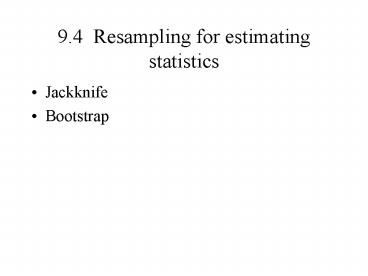9'4 Resampling for estimating statistics - PowerPoint PPT Presentation
1 / 25
Title:
9'4 Resampling for estimating statistics
Description:
Arcing -Bagging -Boosting. Learning with queries ... Bagging ... Bagging improves recognition for unstable classifiers such as decision tree. Arcing ... – PowerPoint PPT presentation
Number of Views:47
Avg rating:3.0/5.0
Title: 9'4 Resampling for estimating statistics
1
9.4 Resampling for estimating statistics
- Jackknife
- Bootstrap
2
Jackknife
- Mean
- Standard deviation
3
Jackknife
- Leave-one-out mean
- Jackknife estimate of mean
4
Jackknife
- Jackknife estimate of variance
- For estimator ?, we let
5
Jackknife
- Jackknife bias estimate
6
Bootstrap
- A bootstrap data set is one created by randomly
selecting n points from the training set D, with
replacement. - In bootstrap estimation, this selection process
is independently repeated B times to yield B
bootstrap data sets.
7
Bootstrap
- Bootstrap estimate of a statistic ? is
- Bootstrap bias estimate is
8
Bootstrap
- Bootstrap variance estimate is
9
9.5 Resampling for classifier design
- We introduce a number of general resampling
methods that have proven effective when used in
conjuction with any in a wide range of techniques
for training classifier - Arcing -Bagging
- -Boosting
- Learning with queries
- Relationship between arcing, learning with
queries and bias and variance
10
Arcing
- Arcing adaptive reweighting and combing, refers
to reusing or selecting data in order to improve
classfication. - Bagging
- Use multiple versions of a training set, each
created by drawing nltn samples from D with
replacement. Each of these subsets is used to
train a different component classifier and the
final classification is based on the vote of each
component classifier. - Bagging improves recognition for unstable
classifiers such as decision tree.
11
Arcing
- Boosting
- Its goal is to improve the accuracy of any
given learning algorithm. It trains successive
component classifiers with a subset of the
training data that is most informative given
the current set of component classifier. - For example, consider creating three component
classifiers for a two-category problem through
boosting. - C1---D1 C2---D2 C3---D3
- If C1 and C2 agree on the category
label of X, we use that label if they disagree,
then we use the label given by C3.
12
Arcing
- Adaboost
- adaptive boostingallows the designer to
continue adding weak learners until some desired
low training error has been achieved. - The training pattern receives a weight which
determines its probability of being selected for
a training set for an individual component
classifier.
13
Learning with queries
- Query to an oracle
- Confidence based query selection an informative
pattern X is one for which the two largest
discriminant functions have nearly the same
value. - Voting based query it is applicable to
multiclassifier systems. The pattern that yields
the greatest disagreement among the k resulting
category labels is considered the most
informative pattern.
14
Learning with queries
- The distributions of query patterns will be large
near the final decision boundaries rather than
that at the region of highest prior probability. - We do not need guess the form of the underlying
distribution, but can instead use non-parametric
techniques to find the decision boundary directly.
15
Relationship
- We stress the need for training a classifier on
samples drawn from the distribution on which it
will be tested. - Not violate because
- -- learning with queries seek decision
boundary instead of model to fit the full
category distribution - -- as the number of component classifiers is
increased, techniques such as general boosting
and Adaboost broaden that class of implemented
functions. It expands space parameters.
16
9.6 Estimating and comparing classifiers
- Parametric models
- Cross validation
- Jackknife and bootstrap estimation of
classification accuracy - Maximum-likelihood model comparison
- Bayesian model comparison
- Problem-average error rate
- Predicting final performance from learning curves
17
Cross validation
- Using training set and validation set to
18
Jackknife and bootstrap estimation
- Jackknife mn m-fold cross validation
- Bootstrap ? bagging
19
Maximum likelihood
20
Bayesian model comparison
21
Problem-average error rate
22
Predicting final performance from learning curve
23
The capacity of a separating plane
24
9.7 combing classifiers
25
Summary
- Formal theory and algorithms taken alone are not
enough, pattern classification is empirical
subject. - Cross validation, jackknife and bootstrap methods
use subsets of the training data to estimate
classifier accuracy. - Maximum likelihood and Bayesian methods use to
compare and choose among models. - Linear weighting and winner-takes-all are to
combine the outputs of separate component
classifiers.































